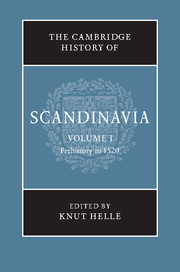Book contents
- Frontmatter
- Introduction
- PART I THE GEOGRAPHY AND PREHISTORY OF SCANDINAVIA
- PART II FROM VIKINGS TO KINGS
- PART III MATERIAL GROWTH (to c. 1350)
- 9 Demographic conditions
- 10 Rural conditions
- 11 Urbanisation
- PART IV THE HIGH MEDIEVAL KINGDOMS
- PART V HIGH AND LATE MEDIEVAL CULTURE
- PART VI LATE MEDIEVAL SOCIETY (c. 1350–1520)
- PART VII SCANDINAVIAN UNIONS (1319–1520)
- Conclusion
- Select bibliography: primary sources, general surveys and secondary works arranged by part
- Index
- Plate Section"
- References
9 - Demographic conditions
from PART III - MATERIAL GROWTH (to c. 1350)
Published online by Cambridge University Press: 28 March 2008
- Frontmatter
- Introduction
- PART I THE GEOGRAPHY AND PREHISTORY OF SCANDINAVIA
- PART II FROM VIKINGS TO KINGS
- PART III MATERIAL GROWTH (to c. 1350)
- 9 Demographic conditions
- 10 Rural conditions
- 11 Urbanisation
- PART IV THE HIGH MEDIEVAL KINGDOMS
- PART V HIGH AND LATE MEDIEVAL CULTURE
- PART VI LATE MEDIEVAL SOCIETY (c. 1350–1520)
- PART VII SCANDINAVIAN UNIONS (1319–1520)
- Conclusion
- Select bibliography: primary sources, general surveys and secondary works arranged by part
- Index
- Plate Section"
- References
Summary
In the Viking Age and the Middle Ages the vast majority of people in the Nordic countries were peasants or people who worked within the framework of the peasant economy. The first clear tendencies towards urbanisation are discernible from the late eighth century. In the ninth century Ribe, Hedeby, Birka and Skiringssal/Kaupang may have had a total of 3,000–5,000 inhabitants. At the end of the tenth century urban development entered a new and vigorous phase (see Chapter 11). The number of towns grew rapidly, especially in Denmark, but with a few exceptions they remained quite small, counting their permanent inhabitants in hundreds or low thousands. Probably only a handful of Scandinavian towns had more than 5,000 inhabitants during the Middle Ages. No towns developed in Iceland or Føroyar. Roughly estimated, Viking Age urban populations barely exceeded 0.5 per cent of the total population in any Nordic country. At the end of the high Middle Ages this proportion may have increased to about 3 per cent in Sweden and Norway; only in Denmark may it have exceeded 5 per cent.
After the establishment of Christian church organisations the clergy came to constitute a social class of its own, and in the course of the high Middle Ages the secular aristocracy of the three Scandinavian kingdoms developed into a privileged nobility in the service of the Crown. These two social élites reached their highest numbers at the end of the high Middle Ages when they may have constituted roughly 2–3 per cent of the population: 1–2 per cent for the nobility and 0.75–1 per cent for the clergy.
Keywords
- Type
- Chapter
- Information
- The Cambridge History of Scandinavia , pp. 235 - 249Publisher: Cambridge University PressPrint publication year: 2003
References
- 3
- Cited by

